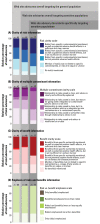Comparative analysis of state fish consumption advisories targeting sensitive populations
- PMID: 19079708
- PMCID: PMC2599751
- DOI: 10.1289/ehp.11372
Comparative analysis of state fish consumption advisories targeting sensitive populations
Abstract
Objective: Fish consumption advisories are issued to warn the public of possible toxicological threats from consuming certain fish species. Although developing fetuses and children are particularly susceptible to toxicants in fish, fish also contain valuable nutrients. Hence, formulating advice for sensitive populations poses challenges. We conducted a comparative analysis of advisory Web sites issued by states to assess health messages that sensitive populations might access.
Data sources: We evaluated state advisories accessed via the National Listing of Fish Advisories issued by the U.S. Environmental Protection Agency.
Data extraction: We created criteria to evaluate advisory attributes such as risk and benefit message clarity.
Data synthesis: All 48 state advisories issued at the time of this analysis targeted children, 90% (43) targeted pregnant women, and 58% (28) targeted women of childbearing age. Only six advisories addressed single contaminants, while the remainder based advice on 2-12 contaminants. Results revealed that advisories associated a dozen contaminants with specific adverse health effects. Beneficial health effects of any kind were specifically associated only with omega-3 fatty acids found in fish.
Conclusions: These findings highlight the complexity of assessing and communicating information about multiple contaminant exposure from fish consumption. Communication regarding potential health benefits conferred by specific fish nutrients was minimal and focused primarily on omega-3 fatty acids. This overview suggests some lessons learned and highlights a lack of both clarity and consistency in providing the breadth of information that sensitive populations such as pregnant women need to make public health decisions about fish consumption during pregnancy.
Keywords: advisory/advisories; benefits; consumption; contaminants; fish; nutrition/nutritional; pregnant women; risks; sensitive populations; women of childbearing age.
Figures



Similar articles
-
The role of sport-fish consumption advisories in mercury risk communication: a 1998-1999 12-state survey of women age 18-45.Environ Res. 2004 Jul;95(3):315-24. doi: 10.1016/j.envres.2004.01.004. Environ Res. 2004. PMID: 15220066
-
Are we reaching the target audience? Evaluation of a fish fact sheet.Sci Total Environ. 2001 Sep 28;277(1-3):77-86. doi: 10.1016/s0048-9697(00)00864-0. Sci Total Environ. 2001. PMID: 11589410
-
Science, policy, stakeholders, and fish consumption advisories: developing a fish fact sheet for the Savannah River.Environ Manage. 2001 Apr;27(4):501-14. doi: 10.1007/s002670010166. Environ Manage. 2001. PMID: 11289450
-
Risks and benefits of consumption of Great Lakes fish.Environ Health Perspect. 2012 Jan;120(1):11-8. doi: 10.1289/ehp.1003396. Epub 2011 Sep 23. Environ Health Perspect. 2012. PMID: 21947562 Free PMC article. Review.
-
Comparison of Recreational Fish Consumption Advisories Across the USA.Curr Environ Health Rep. 2021 Jun;8(2):71-88. doi: 10.1007/s40572-021-00312-w. Epub 2021 May 1. Curr Environ Health Rep. 2021. PMID: 33934293 Free PMC article. Review.
Cited by
-
Considerations and challenges in support of science and communication of fish consumption advisories for per- and polyfluoroalkyl substances.Integr Environ Assess Manag. 2024 Nov;20(6):1839-1858. doi: 10.1002/ieam.4947. Epub 2024 May 16. Integr Environ Assess Manag. 2024. PMID: 38752651 Free PMC article. Review.
-
Potentially Heterogeneous Cross-Sectional Associations of Seafood Consumption with Diabetes and Glycemia in Urban South Asia.Int J Environ Res Public Health. 2020 Jan 10;17(2):459. doi: 10.3390/ijerph17020459. Int J Environ Res Public Health. 2020. PMID: 31936772 Free PMC article.
-
Research into mercury exposure and health education in subsistence fish-eating communities of the Amazon basin: potential effects on public health policy.Int J Environ Res Public Health. 2010 Sep;7(9):3467-77. doi: 10.3390/ijerph7093467. Epub 2010 Sep 16. Int J Environ Res Public Health. 2010. PMID: 20948936 Free PMC article.
-
A uniform fish consumption advisory protocol for the Ohio River.Environ Monit Assess. 2011 Oct;181(1-4):137-51. doi: 10.1007/s10661-010-1819-3. Epub 2010 Dec 18. Environ Monit Assess. 2011. PMID: 21170582
-
Mercury, selenium and fish oils in marine food webs and implications for human health.J Mar Biol Assoc U K. 2016 Feb;96(1):43-59. doi: 10.1017/S0025315415001356. Epub 2015 Sep 8. J Mar Biol Assoc U K. 2016. PMID: 26834292 Free PMC article.
References
-
- Alabama Department of Public Health. Alabama Waterways: Fish Advisories. 2006. [accessed 23 June 2007]. Available: http://www.adph.org/risk/default.asp?templatenbr-0&deptid=145&templateid....
-
- Alaska Department of Health and Social Services, Division of Public Health. Fish Consumption Advice for Alaskans: A Risk Management Strategy to Optimize the Public’s Health—Executive Summary. 2007. [accessed 24 January 2008]. Available: http://www.epi.alaska.gov/bulletins/docs/b2007_29.pdf.
-
- Arizona Game and Fish Department. Fish Consumption Advisories. 2006. [accessed 23 June 2007]. Available: http://www.gf.state.az.us/h_f/fish_consumption.shtml.
-
- Arkansas Department of Health, Game and Fish Commission, Department of Environmental Quality. Fish Consumption Notice—Mercury in Fish. 1999. [accessed 23 June 2007]. Available: http://www.healthyarkansas.com/pdf/fishnotice_mercury.pdf.
-
- ATSDR (Agency for Toxic Substances and Disease Registry) Toxicological Profile Information Sheet. 2007. [accessed 12 November 2007]. Available: http://www.atsdr.cdc.gov/toxpro2.html.
Publication types
MeSH terms
Grants and funding
LinkOut - more resources
Full Text Sources

